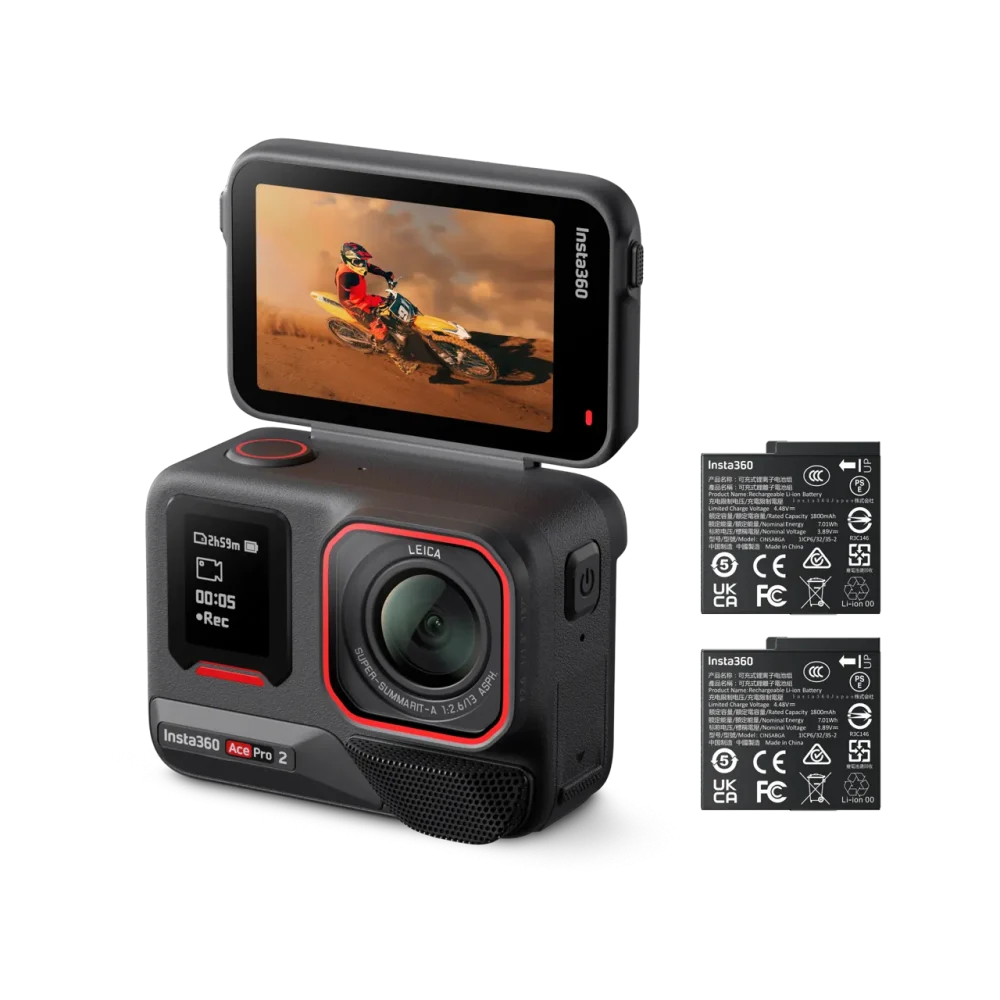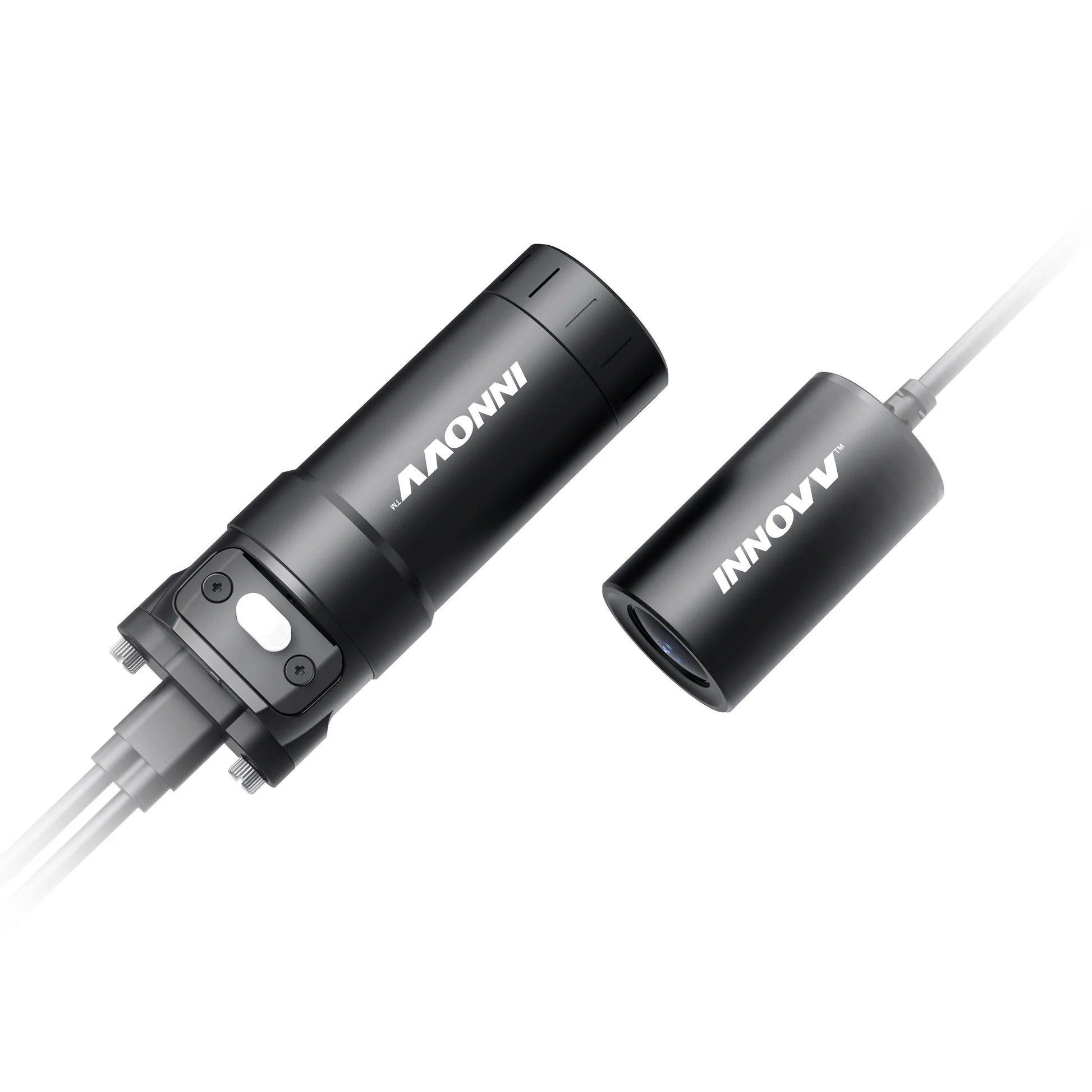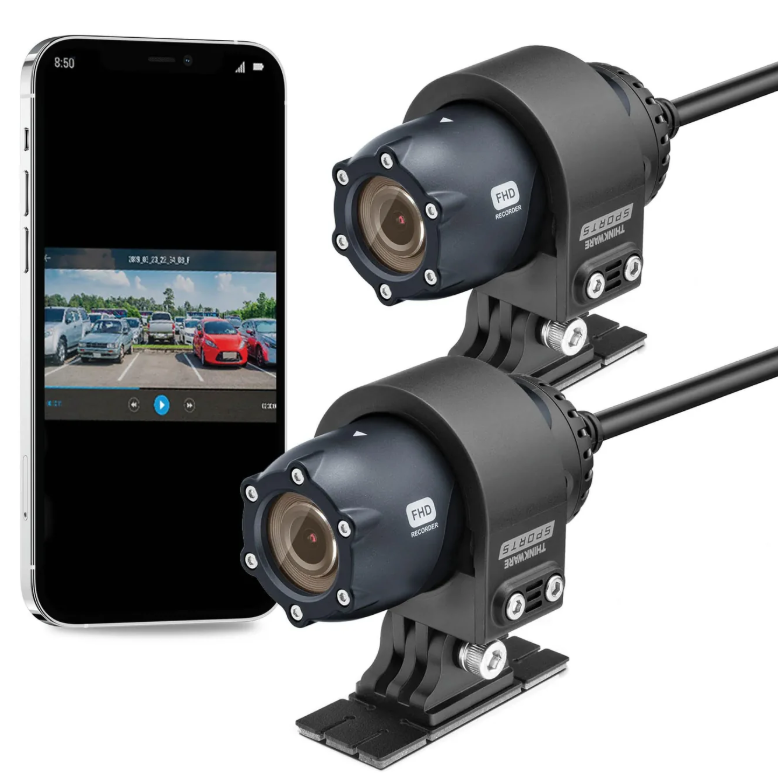
Best Motorcycle Cameras 2025: Action Cams, 360 & Dash cams
left for contents
Your bike sees the best (and worst) parts of every ride. Having a camera rolling means you can save that perfect canyon run, share your favorite backroad twisties, or clip the moments that make even your daily commute worth it.
Helmet cams are fine, but mounting a camera to the bike just works better. You get steadier footage, better angles, and you don’t have to mess with your helmet every time you ride.
If you want to catch the good stuff, or you just want proof in court if you’re hit by a car, having a camera on the bike makes a lot of sense.
Top Motorcycle Cameras & Dash Cams for 2025
The Insta360 Ace Pro 2 Motorcycle Camera Bundle delivers 8K video, AI-enhanced stabilization, and a flip-up touchscreen—designed specifically for riders who want high-quality, easy-to-use action footage. | The Insta360 X5 is a premium 360° action cam with dual 1/1.28" sensors, capturing sharp 8K video even in low light. Built tough with replaceable lenses and waterproofing up to 15m, it’s made for extreme rides. | The INNOVV K6 is a dual-camera dash cam with 2K front and 1080p rear recording, built for clear footage in any weather. Compact, waterproof, and easy to install. |
|
|
|
|
|
|
The Insta360 Ace Pro 2 Motorcycle Camera Bundle delivers 8K video, AI-enhanced stabilization, and a flip-up touchscreen—designed specifically for riders who want high-quality, easy-to-use action footage.
- Excellent low-light performance
- Rock-steady image stabilization
- Flip-up screen for easy framing
- Large file sizes
- Slightly bulky for helmet use
- No built-in storage
The Insta360 X5 is a premium 360° action cam with dual 1/1.28" sensors, capturing sharp 8K video even in low light. Built tough with replaceable lenses and waterproofing up to 15m, it’s made for extreme rides.
- Crisp 8K video, great in low light
- Swap-out, scratch-resistant lenses
- Strong stabilization & wind reduction
- Not compatible with older X-series gear
- Can overheat on long 8K shoots
- More expensive than some rivals
The INNOVV K6 is a dual-camera dash cam with 2K front and 1080p rear recording, built for clear footage in any weather. Compact, waterproof, and easy to install.
- Sharp 2K + 1080p video with great night performance
- Weatherproof (IP67-rated)
- Simple, clean installation
- No remote for manual control
- Awkward microSD card access
- App can be clunky
These picks are built for real riding: vibes, weather, long miles, the works. Let’s dive in.
Before we get into the full list, let’s clear up a few myths about running cameras on bikes:
- “Any action camera works fine on a bike.” Nope. Motorcycle vibrations are brutal. A camera without top-tier electronic image stabilization will produce jittery, unwatchable footage, no matter how expensive it is. Smooth footage is paramount.
- “Dash cams are just for cars.” Increasingly false. With crazy drivers out there, having front and rear facing, always-on cameras recording your ride provides invaluable evidence and peace of mind. Motorcycle-specific dash cams are becoming essential safety gear.
- “Voice control is the best way to operate a camera while riding.” Sounds great in theory, but wind noise, engine noise, and helmet buffeting often make voice commands frustratingly unreliable on a motorcycle. Simple buttons or a dedicated remote are usually more dependable.
- “Just stick it anywhere!” Bad idea. Mounting location drastically affects footage quality (vibration, angle) and camera safety. Using robust, motorcycle-specific mounts in smart locations is critical.
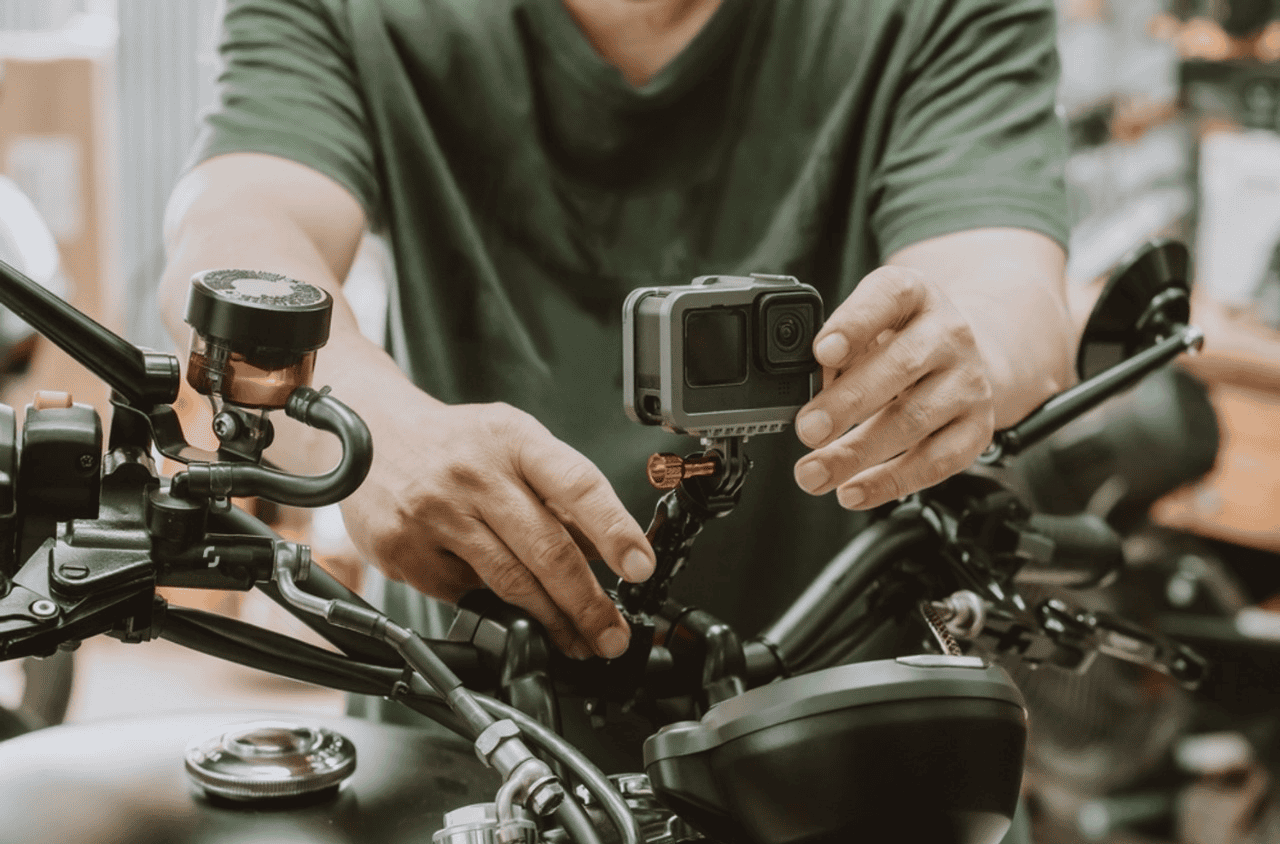
Ready to capture your ride like never before, or add a silent witness to your daily commute? Let’s roll the cameras.
Note: While we covered some great action cameras in our Best Helmet Cameras article, mounting them on the bike presents unique challenges like increased vibration and the need for remote operation. This guide focuses specifically on cameras well-suited for bike mounting and dedicated motorcycle dash cam systems.
Choosing Your Lens: Action Cam vs. Dash cam?
The “best” motorcycle camera depends entirely on your goal:
- Action Cameras (For Documenting Rides): If you want high-quality, cinematic footage of your epic rides, track days, or adventures, an action camera is your tool. They prioritize image quality, advanced stabilization, user control (start/stop recording, changing modes), and often have features like removable batteries and versatile mounting. You actively choose when and what to record.

- Motorcycle Dash Cams (For Safety & Security): If your main goal is a “set-it-and-forget-it” system that automatically records everything as potential evidence or for incident review, a dedicated motorcycle dash cam is the way to go. These typically hardwire to the bike’s power, feature front and rear cameras, loop recording (overwriting old footage), G-sensors (to lock crash footage), and GPS logging. They turn on and off with the bike, recording continuously without rider input.
Let’s look at top contenders in both categories.
Best Action Cameras for Documenting Your Ride
If you want clean, steady footage that actually does your ride justice, these are the cameras to look at. Mount them solid, kill the vibes, and you’re good to go.
Insta360 Ace Pro 2
The Insta360 Ace Pro 2 is a slick setup if you want clean, sharp footage without overthinking it. Built with Leica’s help, it steps things up from the original Ace Pro with better low-light performance, stronger stabilization, faster AI processing, and longer battery life. You still get that big 1/1.3-inch sensor and now you can pull sharper, cleaner footage whether you are riding under wide-open skies or sketchy streetlights.
The flip-up screen is a game-changer out on the bike. You can mount the camera wherever you want, whether it is on the helmet, bars, or tail, and still frame your shot without guessing. FlowState stabilization and Horizon Lock keep everything smooth even when the road turns rough. Voice and gesture controls make it easy to record without letting go of the bars. It is waterproof right out of the box and built tougher against dust and splashes compared to the old model.
Battery life holds up better than the first Ace Pro, but 8K still eats through storage and juice if you are hammering on it. A good vibration-damped mount is still a smart move if you want the footage to stay clean. Some of the new AI tricks kick in more during editing than live, but they are easy enough to play with when you are off the bike.
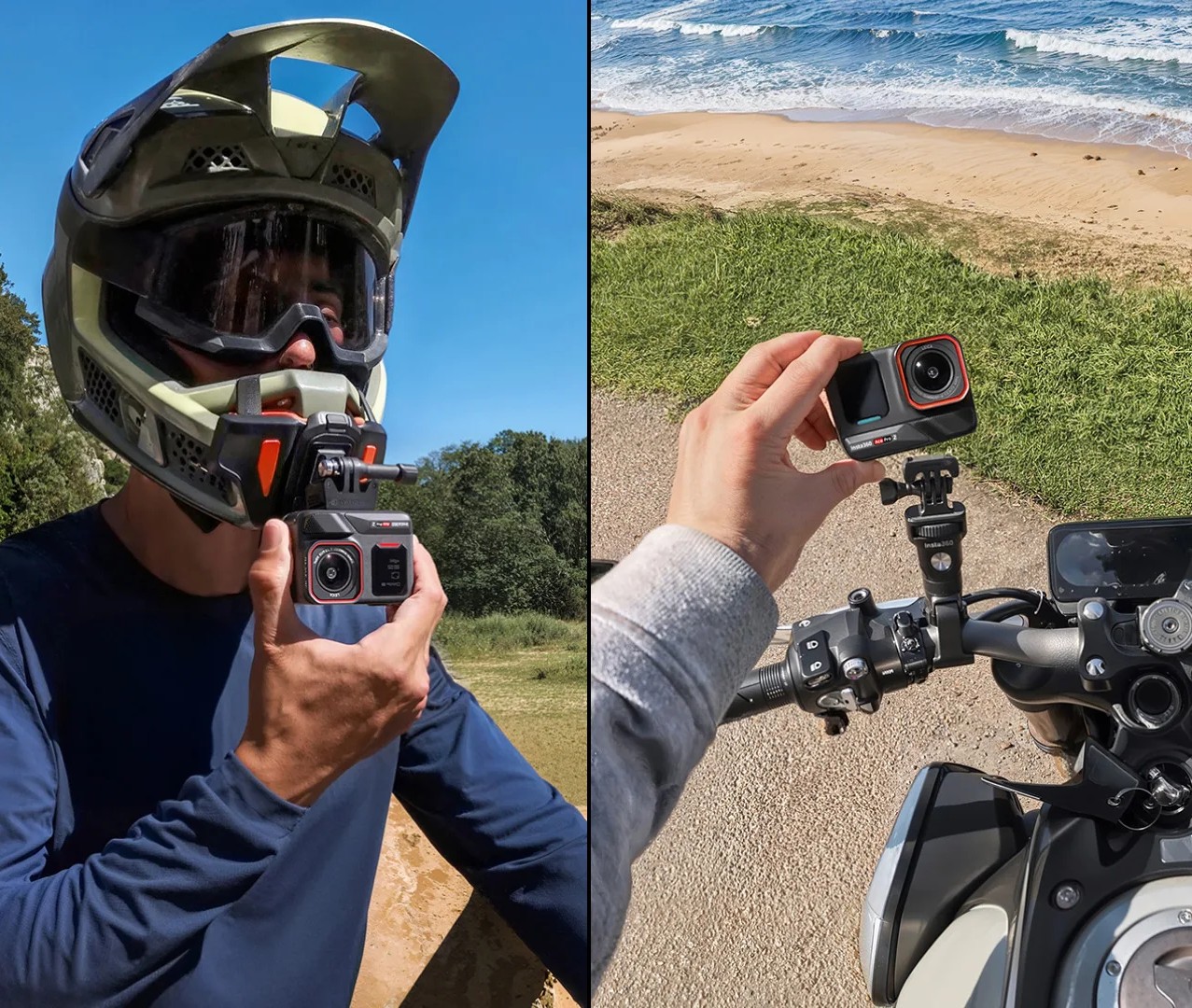
The Catch? It is still not as plug-and-play for bikers as a GoPro. You might have to piece together your perfect setup with a few extra mounts or adapters to really dial it in.
Silver Lining: You get upgraded image quality, a flip screen that actually makes life easier, better stabilization, stronger low-light shots, and smart features that help your footage look sharp without making it a full project every time you ride. For riders who want pro-level footage without the pro-level hassle, the Ace Pro 2 is a solid pick.
Alternative Option: Insta360 X5 (reviewed below) for full 360 capture. Or any GoPro/DJI (mentioned in this list) for more established traditional action cam ecosystems.
The Insta360 Ace Pro 2 Motorcycle Camera Bundle delivers 8K video, AI-enhanced stabilization, and a flip-up touchscreen—designed specifically for riders who want high-quality, easy-to-use action footage.
- Excellent low-light performance
- Rock-steady image stabilization
- Flip-up screen for easy framing
- Large file sizes
- Slightly bulky for helmet use
- No built-in storage
Our Review: That flip screen is handy! The Insta360 Ace Pro combines great image quality, solid stabilization, and unique features perfect for creative ride capture.
GoPro HERO13 Black
We’ve dragged GoPro a bit in our other helmet cam roundup, and fair enough, they haven’t been leading the innovation charge like Insta360 lately. But the HERO13 Black still slaps when it comes to reliable, high-quality footage.
It’s got razor-sharp 5.3K video, buttery-smooth HyperSmooth 6.0 stabilization, and a pile of mounts that work for just about every bike setup out there. Mount it to your fairing or crash bars and you’ll get rock-solid footage, even on rough backroads. Just skip the handlebar unless a shaky cam is your thing.
Horizon Lock keeps your footage level when you’re leaning through corners, and voice control actually works pretty well—when the wind isn’t screaming. The Quik app is solid for quick tweaks or tossing together edits, and the Enduro battery handles cold mornings way better than older GoPros.
It’s waterproof out of the box, tough enough for road grime and rain, and still the easiest to use for riders who just want to hit record and ride.
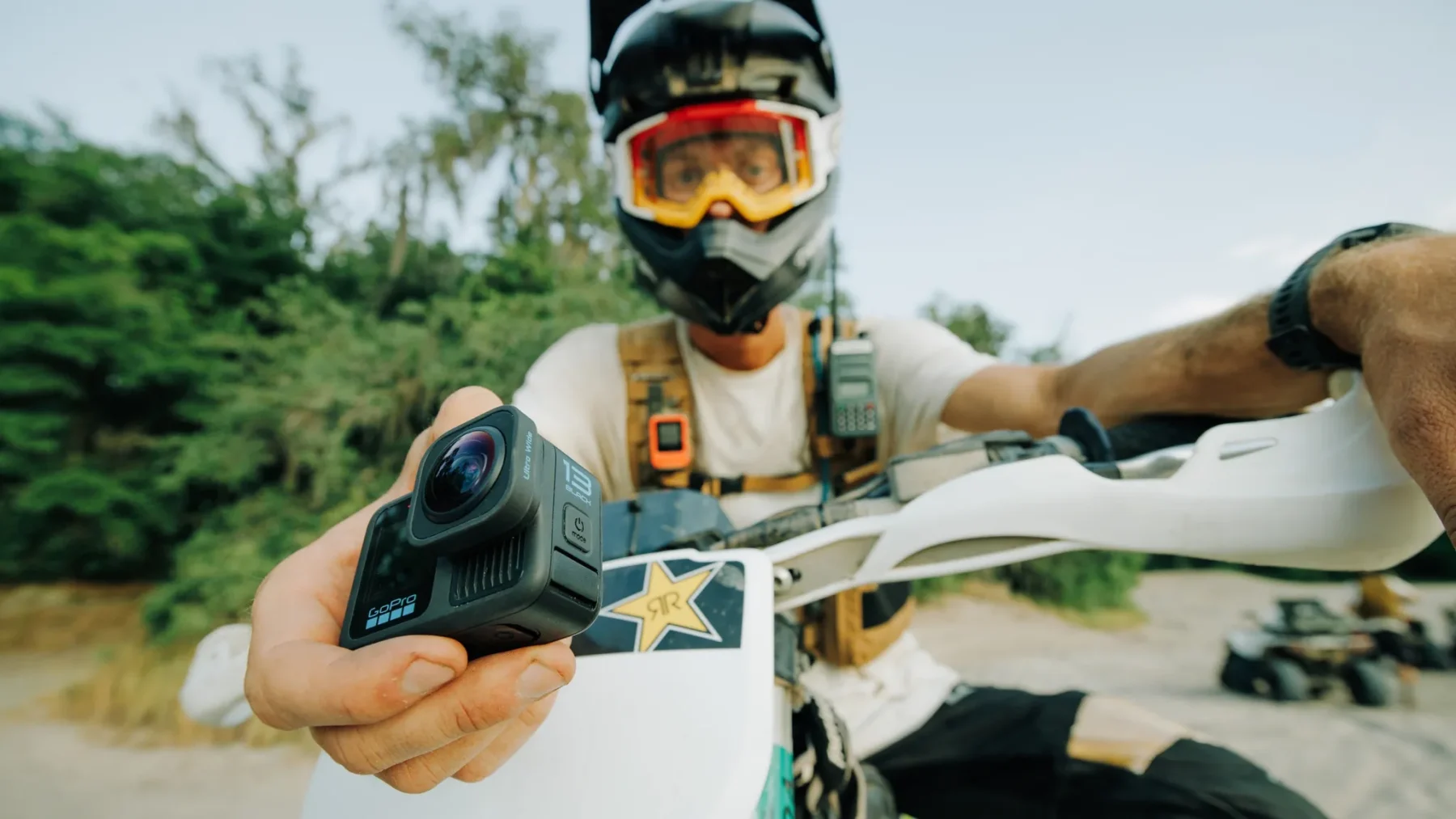
The Catch? GoPro still doesn’t offer a motorcycle-specific vibration-dampened mount, so long-term use without one can mess with the image sensor. Also: voice control can choke in windy conditions, and you’ll need to buy mounts separately. Price is premium too.
Silver Lining: The HERO13 Black delivers one of the cleanest, most stabilized clips you’ll get from any action cam—when mounted right. It’s still the go-to for a reason: easy, dependable, and tons of support gear available.
Alternative option: If you’re looking for better low-light footage and a sleeker mount setup, the DJI Osmo Action 5 offers competitive stabilization and potentially better low-light performance with a convenient magnetic mounting system.
The GoPro HERO13 Black is a top-tier action camera designed for adventurers and content creators seeking high-quality, stabilized footage.It features 5.3K60 video recording, HyperSmooth 6.0 stabilization, and compatibility with new HB-Series lens mods, enhancing its versatility for various shooting scenarios.
- High-resolution 5.3K60 video with improved stabilization
- Interchangeable HB-Series lens mods for creative flexibility
- Enhanced battery life with the 1900mAh Enduro battery
- Incompatibility with older GoPro batteries
- Limited improvements over the HERO12 Black for existing users
- Low-light video quality could be better
Our Review: Despite falling behind in innovation, GoPro nails the basics. The HERO13 Black captures incredible footage, and if you use a proper mount, it’s hard to beat for ease of use and overall quality.
DJI Osmo Action 5 Pro
DJI really brought their A-game with the Osmo Action 5 Pro. Battery life, low-light footage, and how easy it is to mount are all dialed in. The magnetic quick-release mount is slick, makes it super easy to move the camera around on your bike without messing with tools.
The bigger 1/1.3-inch sensor makes a real difference when you are riding at dawn or pushing it late into the evening. Battery life is strong too, easily getting over two hours shooting at 4K/60.
RockSteady 3.0+ keeps the footage nice and smooth, the dual OLED screens are bright and easy to see even in sunlight, and you get 47 gigs of built-in storage plus microSD support. It is waterproof straight out of the box down to 65 feet, no extra case needed.
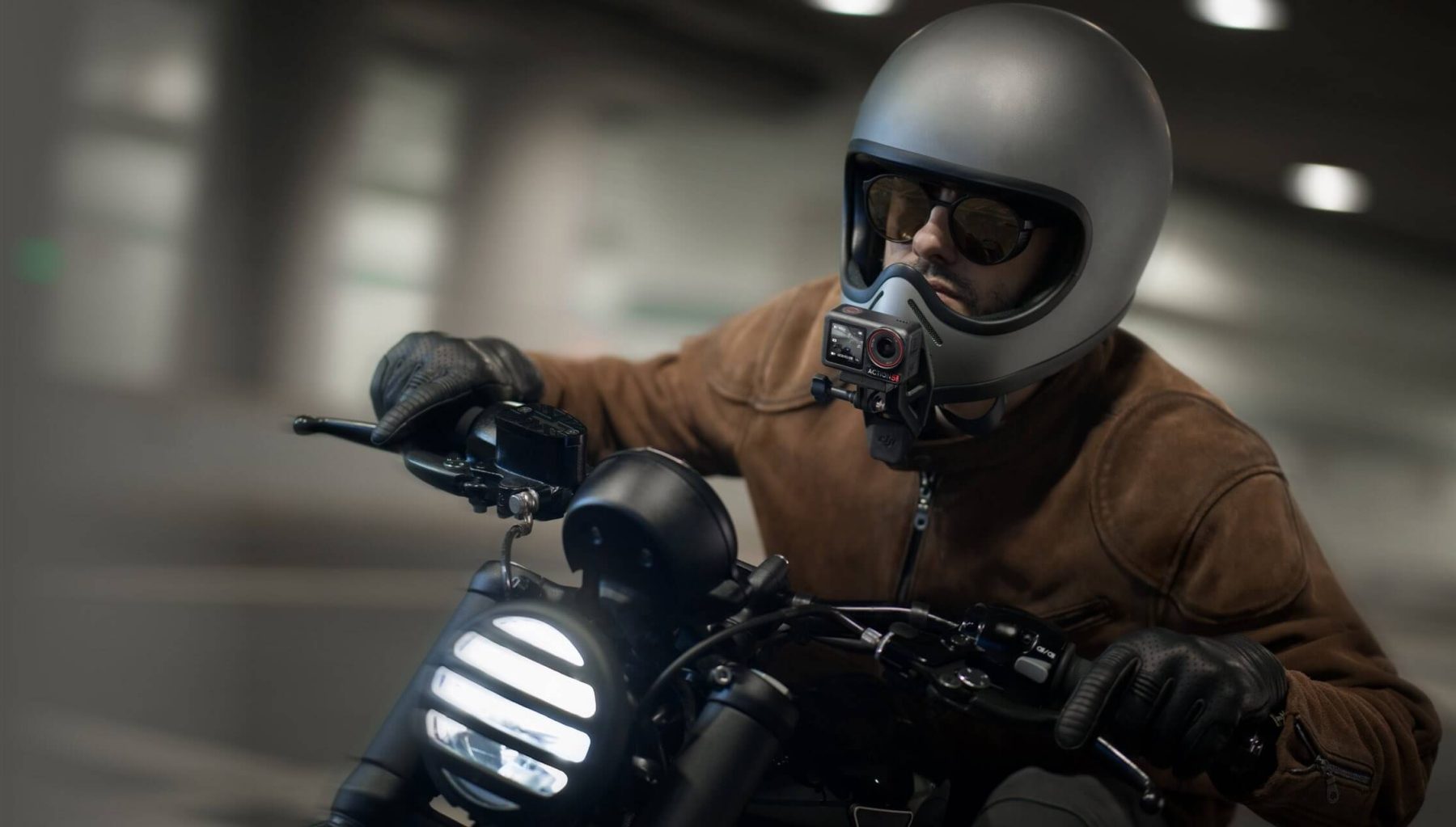
The Catch? Mount ecosystem is slightly smaller than GoPro’s. Still absolutely requires a vibration-damped mount for camera longevity. Max resolution is 4K/120fps (vs GoPro’s 5.3K).
Silver Lining: Offers industry-leading battery life, superb low-light performance, excellent stabilization, deeper waterproofing, and unmatched mounting convenience via its magnetic system. Great value proposition.
Alternative Option: GoPro HERO13 offers higher resolution. Insta360 Ace Pro has a flip screen for selfie mode.
DJI Osmo Action 5 Pro is a rugged 4K action camera built for stunning footage, even in extreme conditions.
- Crisp 4K/120fps with top-tier stabilization
- Dual OLED screens for easy control
- Up to 4-hour battery life
- DJI Mimo editing app not on Google Play
Our Review: Battery king with low-light chops! The DJI Osmo Action 5 Pro’s endurance, image quality, and magnetic mount make it a fantastic, convenient choice for bike-mounted recording.
Insta360 X5 (360 Camera)
If you want the sharpest, craziest 360 footage of your rides, the Insta360 X5 is the heavy hitter right now. It pulls full 8K 360 video at 30fps, so you mount it once, bars, tail, helmet, wherever, and it grabs every damn angle in crystal-clear detail. Building upon the strengths of its predecessor, the X4, the X5 introduces sharper 8K capture, bigger low-light sensors, longer battery life, tougher waterproofing, and the game-changing ability to swap out busted lenses without sending the whole thing in. It is built for riders who want to capture it all without messing around.
Night rides? No sweat. The bigger sensors and PureVideo mode actually make low-light shots usable instead of a grainy mess. One of the best upgrades is the new replaceable lenses. You wreck one, you swap it yourself and get back out there. No downtime, no expensive repairs. Battery life is stronger too. You get around 185 minutes recording at 5.7K, which means way less stressing about your battery dying halfway through a ride.
FlowState stabilization and 360 Horizon Lock keep everything butter-smooth even when the road turns to garbage. You can flip it into single-lens mode if you do not need full 360 and just want a solid 4K cam. Plus, it is built tough with an IP68 rating, so rain, dust, even an accidental drop in a puddle will not kill it.

The Catch? Editing 360 footage requires an extra step (reframing) compared to standard video. While 8K capture is impressive, the final reframed flat video quality might not be quite as sharp as native 5.3K/4K from the best dedicated flat action cams. The dual lenses are inherently vulnerable (though guards help). Premium price.
Silver Lining: You get insane creative freedom. Shoot first, figure it out later. Impossible drone-like shots, crazy rearward or side angles, smooth tracking, all without a camera crew or sketchy mounts. If you want next-level footage that actually makes your rides look as good as they feel, the X5 is the way to go. For a more portable flying option, check out our full HoverAir X1 Pro Drone Review.
Alternative Option: The GoPro MAX offers 360 capture within the GoPro ecosystem, though typically at lower resolutions than the X5.
Premium 360° action cam with dual 1/1.28" sensors, capturing sharp 8K video even in low light. Built tough with replaceable lenses and waterproofing up to 15m, it’s made for all kinds of riding.
- Crisp 8K video, great in low light
- Swap-out, scratch-resistant lenses
- Strong stabilization & wind reduction
- Not compatible with older X-series gear
- Can overheat on long 8K shoots
- More expensive than some rivals
Our Review: The Insta360 X5’s 8K 360 capture, amazing stabilization, and reframing freedom make it incredibly versatile for unique bike footage.
Best Motorcycle Dash Cams for Safety & Security
Sometimes it’s not about getting the perfect shot. It’s about having proof when things go wrong. These bike-mounted dash cams run in the background, recording everything so you can just focus on the ride.
INNOVV K5/K6 Motorcycle Dash Cam
When you start talking about real-deal motorcycle dash cams, INNOVV is a name that keeps coming up.
Their setups, like the K5 and the newer K6 and K7, are built for bikes from the ground up. Dual cameras, solid construction, and all the safety features you actually want.
It’s like having a front and rear witness rolling the whole time you ride. The main DVR usually tucks under the seat, and then you run little weatherproof cameras up front and out back.
The K5 shoots 4K up front and 1080p out back, which is plenty sharp for catching plates and traffic. They hardwire into your ignition, so they fire up and start recording when you turn the key. You also get stuff like loop recording, crash detection with a G-sensor, GPS tracking, WiFi connection to your phone, and even parking mode if you want to keep an eye on things when you are parked.
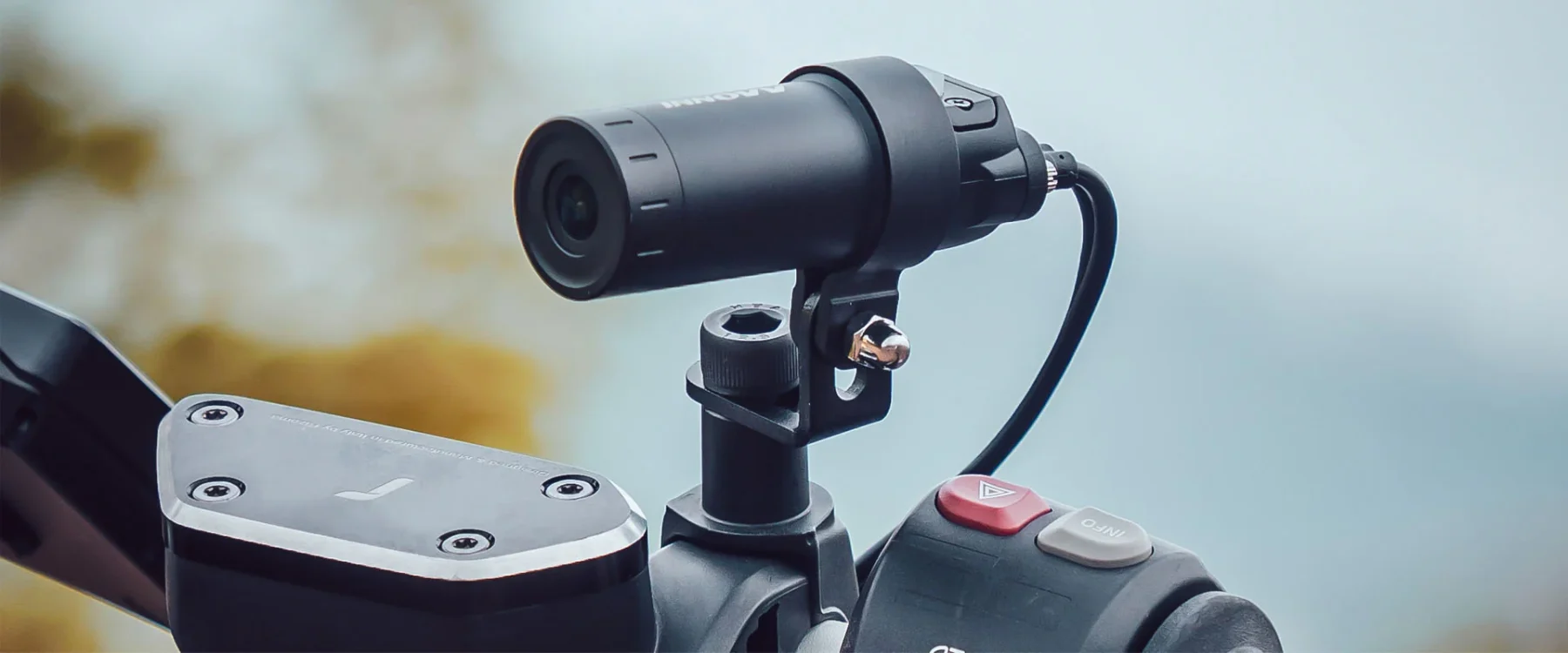
The Catch? Installation is involved (wiring, component placement). Premium price. Requires a good microSD card (sold separately).
Silver Lining: Provides dedicated, automatic, dual-channel recording designed for motorcycles. Offers crucial safety features in a reliable, set-and-forget system.
Alternative Option: Thinkware is another reputable brand offering dedicated powersports dash cams like their M1 model. It provides similar dual-channel, hardwired recording with weatherproofing, GPS, and stabilization features, often presenting a strong alternative to INNOVV systems for riders seeking set-and-forget protection.
The INNOVV K6 is a dual-camera dash cam with 2K front and 1080p rear recording, built for clear footage in any weather. Compact, waterproof, and easy to install.
- Sharp 2K + 1080p video with great night performance
- Weatherproof (IP67-rated)
- Simple, clean installation
- No remote for manual control
- Awkward microSD card access
- App can be clunky
Our Review: Set-and-forget safety. INNOVV systems like the K-series are top choices for dedicated, reliable motorcycle dash cam recording, front and rear.
Thinkware M1 Motorsport Dash Cam
The Thinkware M1 is another solid setup built for bikes and powersports. It gives you dual 1080p recording front and rear, using good Sony STARVIS sensors that keep footage sharp day or night.
One thing that stands out is the built-in electronic image stabilization. It does a good job smoothing out the bumps and vibration from the road, so your footage stays clear even when the ride gets rough.
The cameras and DVR are all IP66 rated, so no worries about rain or dust killing your system.
Like most good setups, it hardwired into your ignition for automatic start and stop, runs loop recording, logs GPS speed and location, and hooks up to your phone with WiFi. Most kits also pack a G-sensor to lock footage if you take a hit, but it is always good to double-check depending on the package you get.
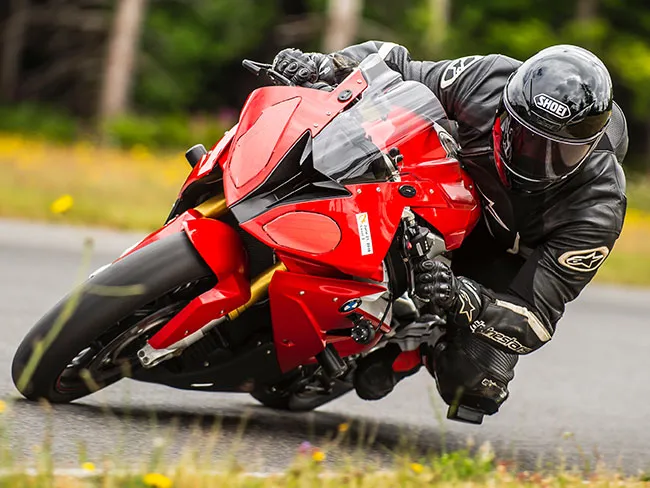
The Catch? Max resolution is 1080p, lower than the INNOVV K5’s 4K front camera. Installation still requires careful wiring and placement of the components. Max supported SD card size might be smaller than some competitors (the last upgrade supports 128GB).
Silver Lining: Offers excellent full-system weatherproofing (IP66), crucial Electronic Image Stabilization for smoother video, and core dashcam features (Dual 1080p, GPS, WiFi, Auto Record) from a highly reputable dash cam brand. Strong reliability.
Alternative Option: INNOVV K-series offers 4K front resolution potential. Budget brands like VSYSTO offer more features for less money but they not match the advanced stabilization features of the M1.
The Thinkware M1 is a rugged dual-channel dash cam for motorcycles, offering 1080p front and rear recording with image stabilization and night vision. Built tough with an IP66 weatherproof rating.
- Clear dual 1080p footage with wide-angle lenses
- Stabilized video and enhanced night clarity
- Weatherproof and built for rough conditions
- Max 1080p resolution only
- Limited to 64GB microSD storage
- App interface isn’t very user-friendly
Our Review: The Thinkware M1 is a robust, weatherproof, dual-channel dashcam with vital EIS, making it a top contender for reliable ride recording.
Motorcycle Camera Comparison
Action & 360 Camera Comparison:
| Feature | Insta360 Ace Pro 2 | DJI Osmo Action 5 Pro | GoPro HERO13 Black | Insta360 X5 (360) |
| Primary Use | Ride Documenting (Vlog) | Ride Documenting (Vlog) | Ride Documenting | Ride Doc (360/Refrm) |
| Max Resolution | 8K/30fps, 4K/120fps | 4K/120fps, 2.7K/240fps | 5.3K/60fps, 4K/120fps | 8K/30fps (360) |
| Stabilization | FlowState | RockSteady 3.0+ & HorizonSteady | HyperSmooth 6.0 | FlowState + 360 Horizon Lock |
| Key Features | Flip Screen, Leica Lens, PureVideo, Removable Lens Guard | Dual Touchscreens, Long Battery Life | Voice Ctrl, GPS, HB-Lenses*, HLG HDR | 360 Cap, Reframe, Invisible Stick, Replaceable Lens, InstaFrame |
| Waterproof (Native) | 39 ft (12m) | 33 ft (10m) | 33 ft (10m) | 49 ft (15m) |
| Vibe Dampening | Mount Dependent | Mount Dependent | Mount Dependent | Mount Dependent |
| Price Range | $$$(Premium) | $$ (Upper Mid) | $$(Upper Mid) | $$$ (Premium) |
| Get One | Check Price | Check Price | Check Price | Check Price |
*Note: GoPro HERO13 Black HB-Series Lenses sold separately. Check specific models for exact specs, features, and current pricing.
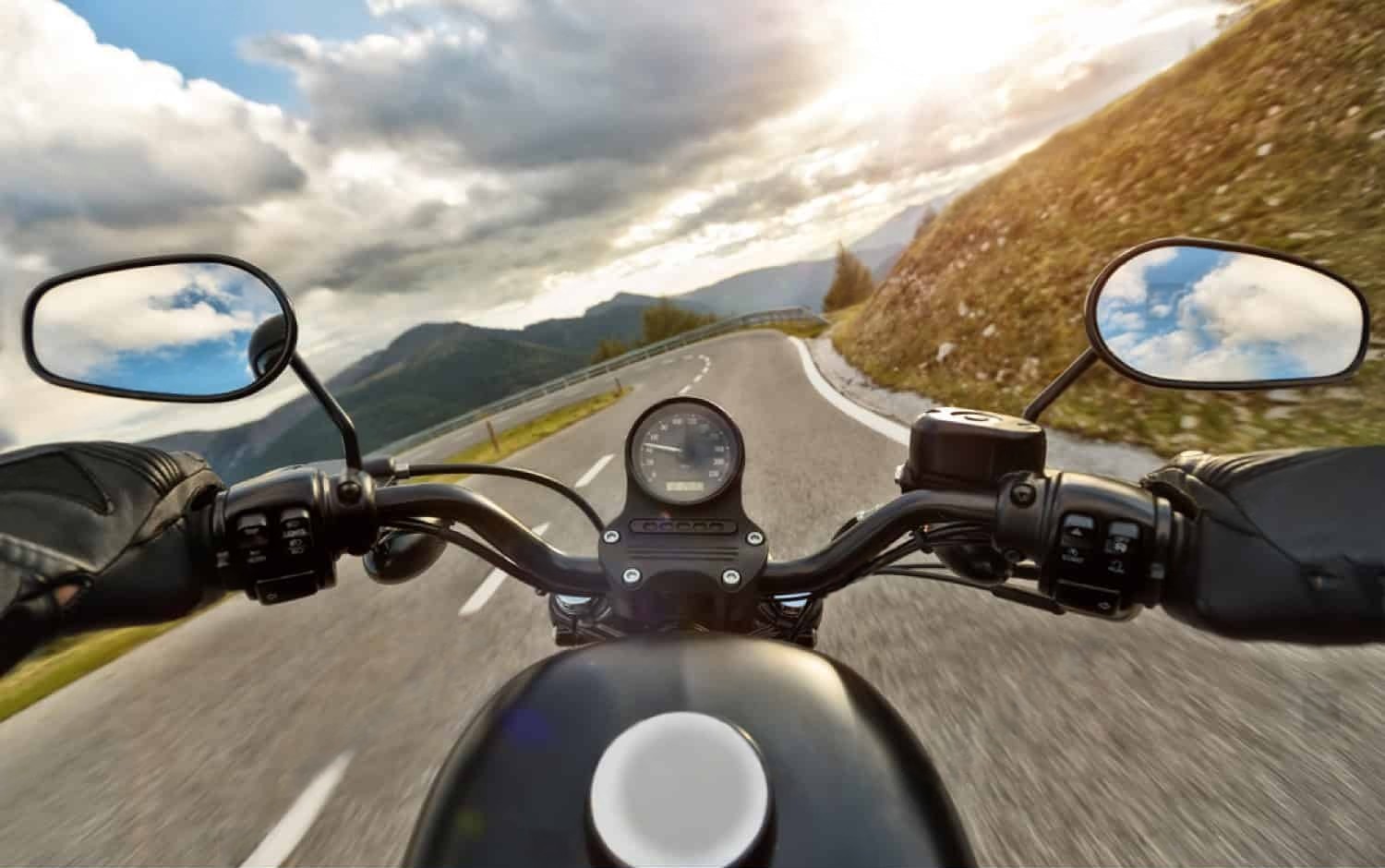
Motorcycle Dashcam Comparison:
| Feature | INNOVV K-Series (K5/K6) | Thinkware M1 |
| Primary Use | Safety / Dashcam | Safety / Dashcam |
| Channels | Front & Rear | Front & Rear |
| Max Resolution | 4K Front / 1080p Rear | 1080p F&R @ 30fps |
| Key Features | GPS, WiFi, G-Sensor, Loop, Parking Mode | EIS, GPS, WiFi, G-Sensor, Loop |
| Auto Start/Stop | Yes (Hardwired) | Yes (Hardwired) |
| Waterproof Rating | Cameras IP67/68, DVR Varies | Cameras & DVR IP66 |
| Price Range | $$$$(Premium) | $$-$$$ (Upper Mid-Range) |
| Get One | Check Price | Check Price |
Note: Check specific models for exact specs, features, and current pricing.
Buying Guide: Choosing Your Motorcycle Camera
Picking the right camera depends on why you want one. Below are the key factors to consider:
Use Case
- Documenting rides? Prioritize image quality (resolution, color), stabilization, user control (remote/voice), battery life, and mounting flexibility. Popular options include GoPro, DJI, and Insta360.
- Recording for safety? Look for hardwired setups with loop recording, G-sensor, dual channels (front/rear), GPS, and strong weatherproofing. Dash cam examples: INNOVV, Blueskysea.
Image Quality
- Higher resolution (4K+) and frame rates (60fps+) improve detail, especially for slow-motion footage.
- Low-light performance matters if you ride at dawn or dusk.
- Dash cams may sacrifice some visual quality in favor of reliability and features.
- Higher resolution (like 4K) captures sharper detail and better color — especially noticeable when riding or recording slow-motion footage.

Stabilization (CRITICAL for Bike Mounts)
- Top-tier stabilization tech (HyperSmooth, RockSteady, FlowState) is a must for watchable footage.
- Action cams benefit from vibration-damped mounts to protect the sensor over time.
- Dash cams are less sensitive but still need stable mounting for clear footage.
Mounting
- Choose smart mount locations: handlebars, frame, fairing stay, under-tail.
- Avoid plastic mounts in high-stress areas.
- Make sure your chosen location doesn’t block controls or suspension.
- Dash cams require discreet, secure placement for front/rear lenses.
Power
- Action cams typically run for 1–1.5 hours on battery.
- For longer rides, use a power bank in a tank bag or tap into the bike’s USB port (ensure weatherproofing).
- Dash cams should be hardwired into the bike’s switched power so they turn on/off with the ignition.
- This setup is more reliable but requires a proper wiring install.
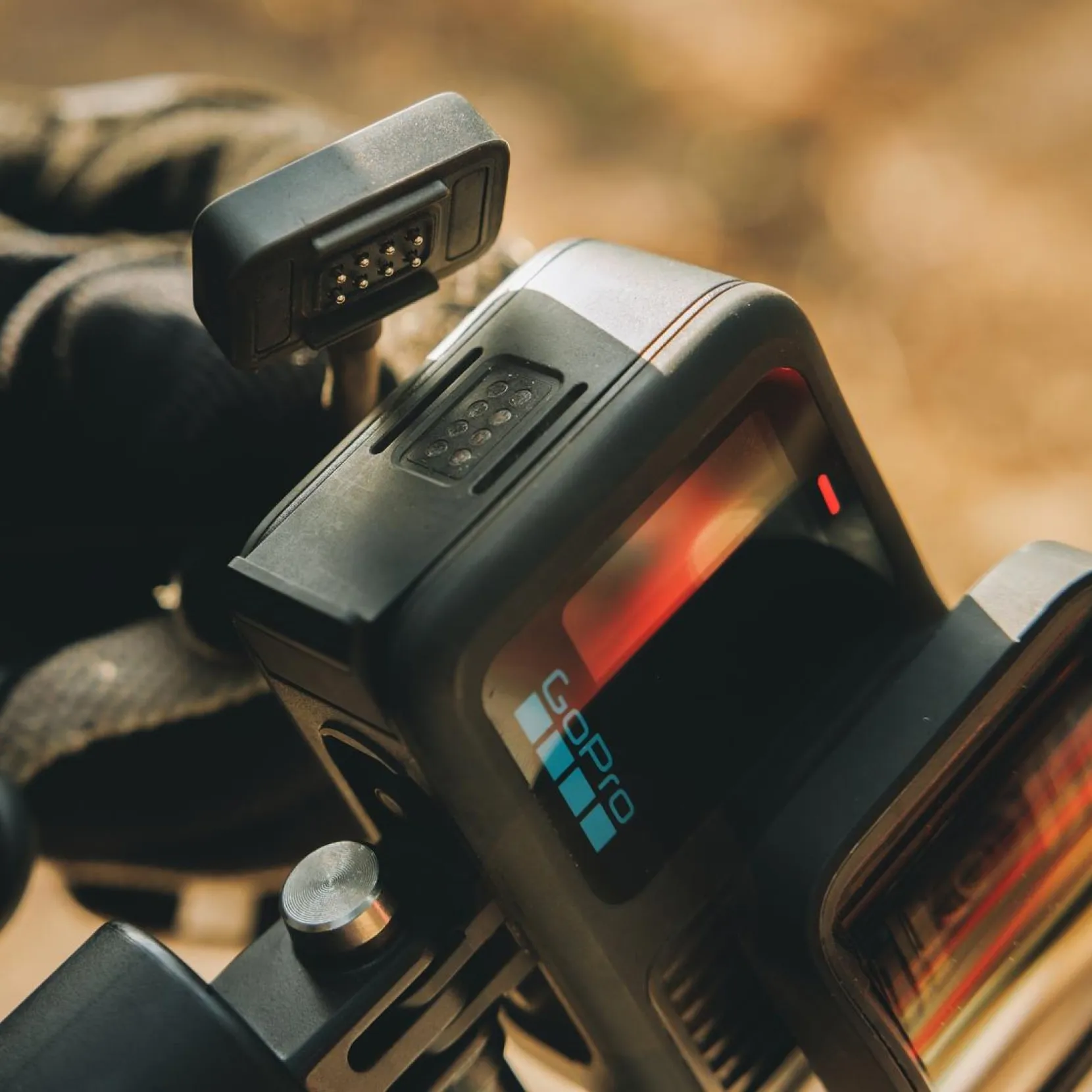
Control (While Riding)
- Buttons: Simple and reliable, but might require stopping or reaching awkwardly.
- Voice Control: Convenient when it works, but often struggles with wind/engine noise.
- Remote Control: Dedicated Bluetooth remotes (often wrist-mounted) are usually the most reliable way to control action cams while riding.
- App Control: Good for setup and reviewing footage when stopped.
- Dash cams: Set-and-forget, no control needed while riding.
Dash cam Specific Features:
- Loop Recording: Automatically overwrites oldest footage when card is full. Essential.
- G-Sensor: Detects impacts and automatically locks the current video file from being overwritten.
- GPS: Records speed and location data alongside video. Useful for context/evidence.
- Dual Channel: Records front and rear simultaneously. Highly recommended.
- Parking Mode: Records if impact is detected while parked (requires constant power connection/battery management).
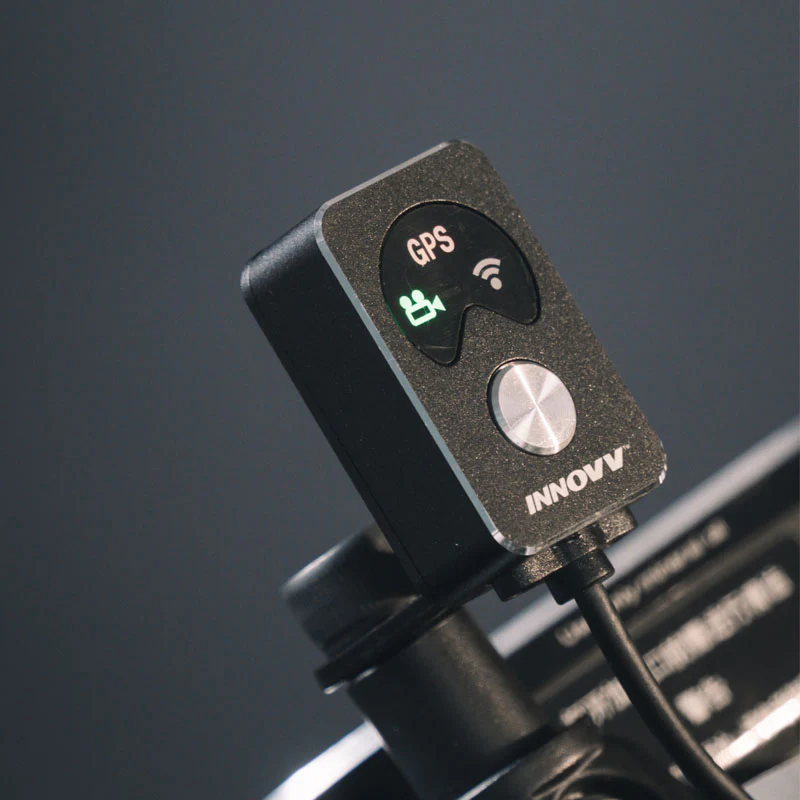
Weatherproofing
- Action cams should be IPX7/IPX8 rated or use waterproof housings.
- Dash cams often have IP67/IP68-rated lens housings.
- Make sure any power or audio ports used are also sealed or weatherproofed.
Storage
- Both camera types use microSD cards.
- Look for high-endurance V30+ cards to handle constant recording/rewriting.
- Larger capacities let you record more before looping or offloading is needed.
FAQs: Motorcycle Camera Questions Answered
Are motorcycle dash cams worth it?
Absolutely, for many riders. They provide objective evidence in case of accidents, disputes, or insurance claims (“he said, she said”). Front and rear cameras offer the best protection against being wrongly blamed. The peace of mind alone is often worth the investment.
Where is the best place to mount a camera on a motorcycle?
Mounting depends on your goal.
- Action Cams (Documenting): Handlebars (can be vibey), frame sliders, engine guards, fairing stays, swingarms, under-tail – experiment for unique, stable angles. Avoid direct engine/exhaust mounting due to heat/vibration.
- Dash cams: Front lens usually near the headlight/forks, rear lens near the license plate/tail light. DVR unit typically under the seat or in storage. Aim for discreet, protected locations with clear views.
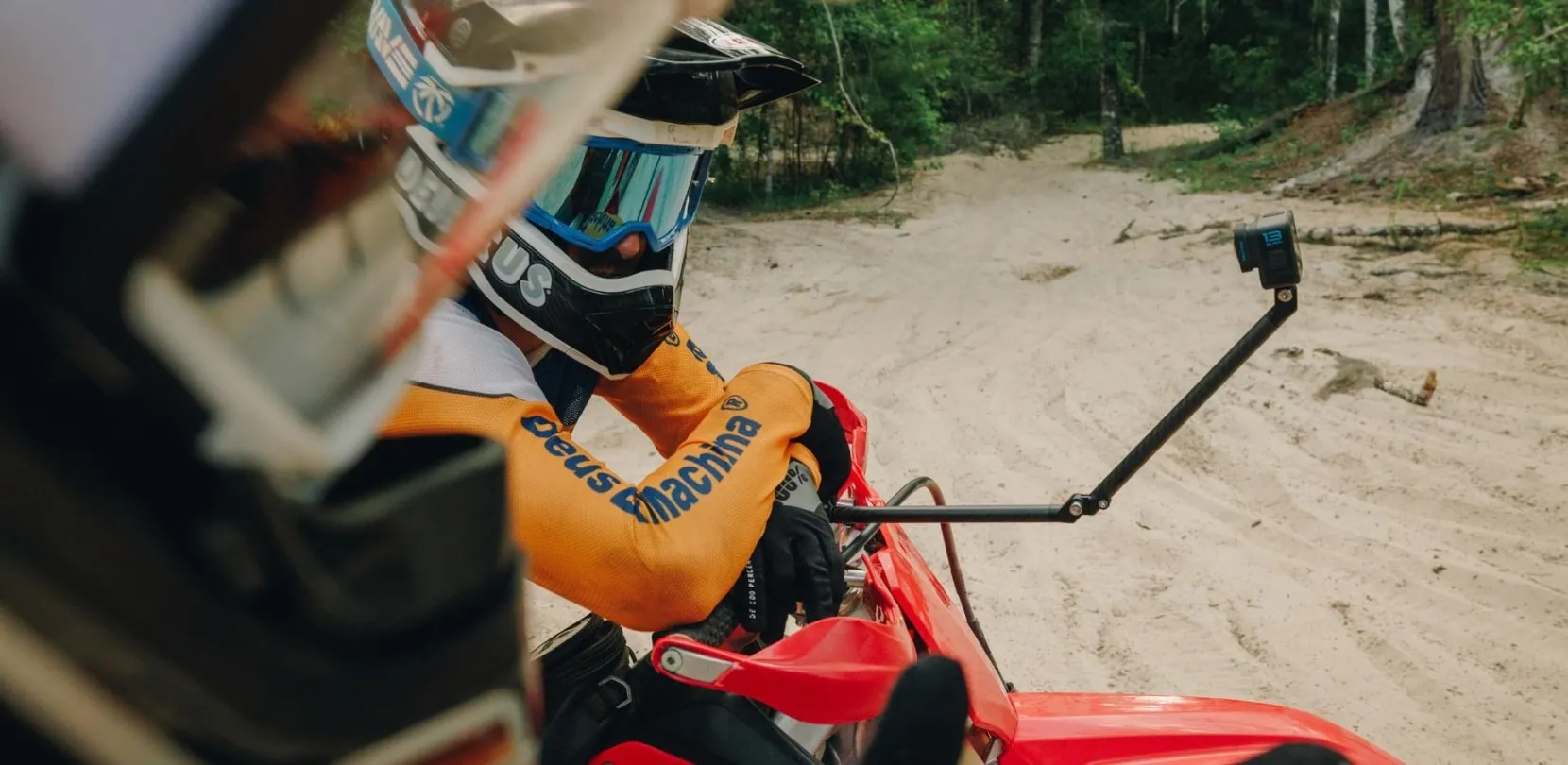
How do motorcycle dash cams get power?
Dash cams are typically hardwired to the bike’s electrical system. One wire connects to a switched power source (live only when the ignition is on), another to constant power (for parking mode), and one to ground. This setup allows the dash cam to automatically turn on and off with the bike.
Can action cameras be used as dash cams?
Yes, but with limitations. Most action cams can loop record, but lack features like automatic ignition-based start/stop, G-sensor event locking, and simultaneous front/rear recording (unless using two cameras). Battery life and weatherproofing external power are also concerns for continuous use. A dedicated dash cam is generally better for set-and-forget safety recording.
Whether you are chasing views or just covering your ass, getting a camera on the bike has never been easier.
Ride safe out there.
Related
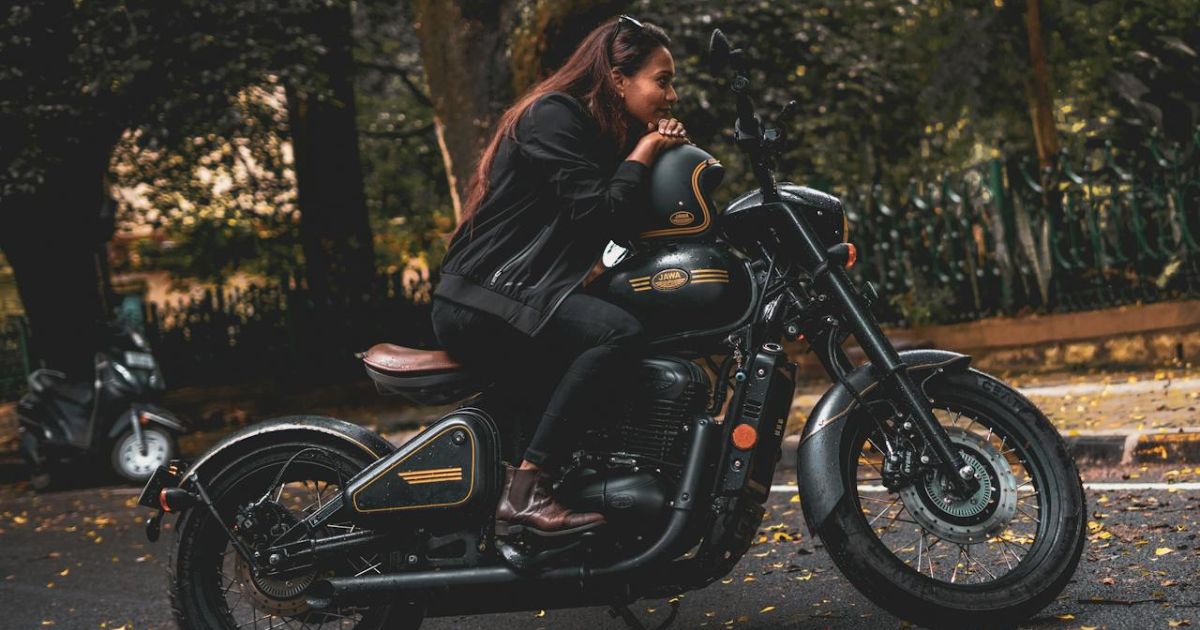
Best Motorcycle Gear for Women: Stylish, Safe & Confident
Discover the best motorcycle gear for women—tested for protection, comfort, and style to keep every rider confident, cool, and safe on the road.

